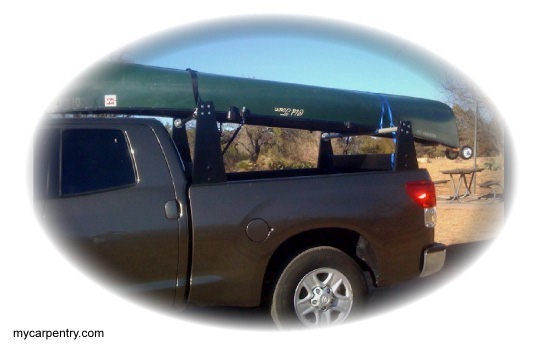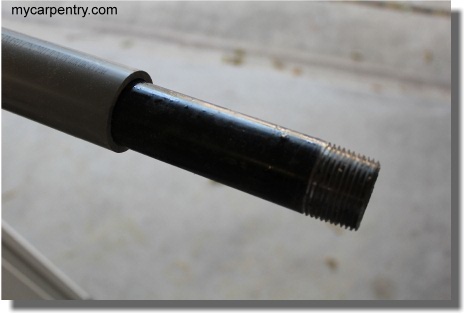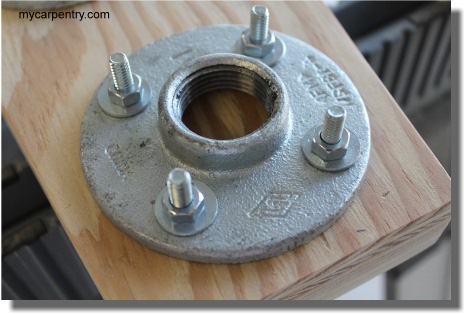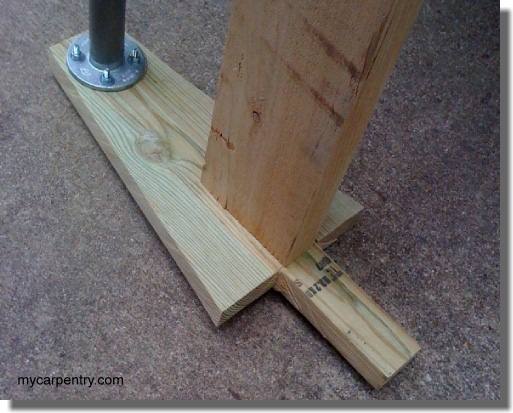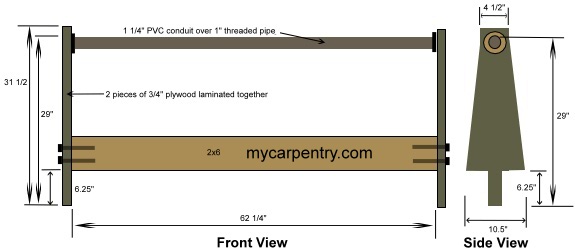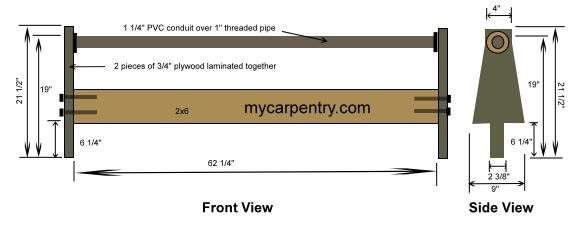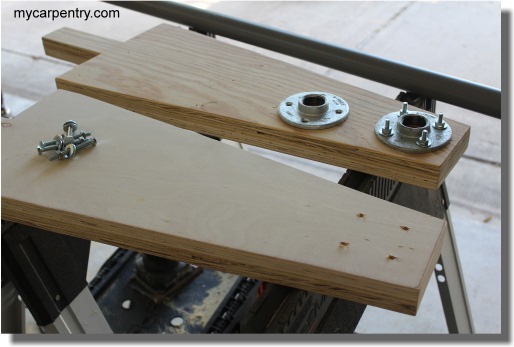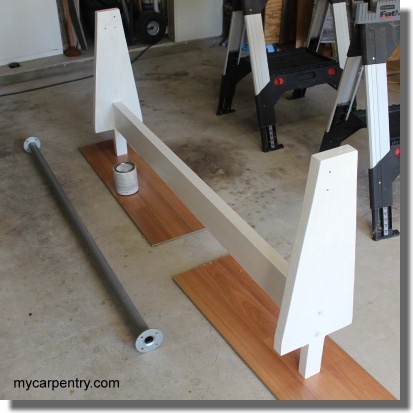Truck Ladder Racks
Truck ladder racks are easy to build and you can save big bucks! Brand name truck racks can be expensive. I looked at several popular brands and was surprised at how much they cost. Ladder racks seemed relatively simple, so why not build them myself?
I did some calculations and concluded that I could build my own custom truck ladder racks for about half of what the brand name racks cost.
The racks described here were built specifically for a 2010 Toyota Tundra, but you can apply the same design concepts to your needs, and change the dimensions to match those of your vehicle. Also, though I could actually use them as ladder racks, I built mine to be primarily canoe racks. My canoe weighs about 80 lbs. (36 kg.).
The goal was to design my custom racks so that they would easily carry my canoe, plus anything else I might want to carry. I don't own a kayak, but I might someday, and they typically weigh less than canoes, so they would also make a great kayak rack system. All of the ladders I own weigh less than my canoe too, so as long as my racks can carry at least 80 lbs., then I should be okay.
I had an overall vision of what I wanted. Here are a few key points:
- The racks needed to be easily removable.
- The racks needed to be installed so that no holes would be drilled in the bed of the truck.
- The racks needed to be able to carry the weight of my canoe.
You may have noticed in the picture above, that the back rack is lower than the front rack. I did this to make it easier for me to load my canoe. You can do this too, or you can make the back rack the same as the front rack, but keep in mind that, whatever you are planning to carry with these racks, there's not something extending below the horizontal bar that would dent the top of your cab. These particular racks are designed with close clearance.
Designing the Custom Truck Ladder Racks
While still in the envisioning stage of my ladder rack project, I went to the hardware store to see what hardware was available that I could include in my design.
I concluded that 1" pipe, to use as the horizontal support, would be plenty strong enough to carry the required weight, but to function well as a canoe rack, I wanted something a little smoother to drag my canoe over so that the gunwales would not get scratched. I discovered that 1 1/4" PVC conduit would fit smoothly over the black plumbing pipe and would provide a smooth surface to drag my canoe over.
The pipe could be cut to length and threaded on both ends so that it could be screwed into pipe flanges that could be bolted onto wooden uprights.
That is the basic design of my truck ladder racks - horizontal pipe with flanges on each end, mounted to wooden uprights that fit into the stake bed holes of my truck.
Now that the basic design has been done, I needed to determine the size and shape of the uprights and the material I was going to use for them.
I made the back canoe rack first and used scrap 2x10 pressure treated pine as the material. This seemed strong enough, and probably would be just fine, but I thought about the future, and what might happen if the wood were to split and crack with age.
I built the front racks using two pieces of 3/4" plywood laminated together with wood glue, thinking that this choice of material would never develop a split, and would probably be less likely to cup or crook.
Since I already built the back rack using pressure treated pine, I didn't see the need to rebuild it using plywood (at least not at this time). I suppose that time will tell, and after a few years, I might even determine that pressure treated pine works just as well, if not better than plywood.
Building the Custom Truck Ladder Racks
The two diagrams below show the dimensions of the front (taller) and rear (shorter) racking system. If you want them both to be the same size, the front rack will also fit in the rear of your Toyota Tundra.
Here is a list of the materials that you will need to build both racks:
- 2 sections of 1" steel pipe @ 61 3/4" long (threaded on both ends)
- 2 sections of 1 1/4" PVC conduit 61 1/2" long
- 4 pipe flanges (for the 1" pipe)
- 2 2x6 rough cedar planks @ 62 1/4" long (for the horizontal support)
- 8 5/16" lag bolts @ 5" long (to bolt the 2x6 cedar planks between the uprights)
- 8 5/16" washers
- 16 3/16" bolts @ 2 1/2" long
- 16 washers
- 16 3/16" nuts
- 1 quart of wood primer
- 1 quart of enamel paint
- 1 small bottle of wood glue
The material list above should cover everything except for the material used in the uprights, and that depends on the materials you choose to use (either 2x10 or plywood). If you are using 2x10, one 12' length should be enough to build either two "front" racks, or one "front" rack and one "rear" rack.
If you choose plywood, 1 sheet of 3/4" plywood (exterior grade) should be plenty to cut the 8 upright shapes.
Truck Ladder Racks - Assembly
- Cut all of the upright parts using a table saw, circular saw, or jigsaw, choosing either method below, depending on which material you have decided to use, plywood or 2x10:
- a) - 2x10 - cut the 2x10 pieces to length, and then cut them to the shape of the uprights as shown in the diagrams.
- b) - Plywood - cut out each upright shape. You will need two pieces for each upright. Laminate two 3/4" pieces together with wood glue to make them into one upright that is 1 1/2" thick. (see below) Nail the plywood sections together with 1 1/4" finish nails to hold them together until the glue sets.
- Sand the assembled sections of plywood (or pressure treated 2 x
10) until all of the edges are smooth and free of splinters. While
sanding the surfaces, be sure to round all of the corners,
particularly the posts that will fit into the stake bed holes of
your truck. This will make them fit better.
- Position the flanges on the uprights at their specified
location, and use them as a template for marking the holes for the
3/16" bolts, and drill 1/4" holes in the uprights. (do not bolt
them in yet)
- Place two of the uprights in opposing stake holes and measure
the distance between them. On my truck, the measurement was 62
1/4", but yours may be different. This will be the length that you
will cut the 2x6 cedar plank.
- Without removing the uprights from the stake bed holes, place
the 2x6 cedar spacing plank between them and center it.
Once it is centered, drill two holes on each outside end of the
uprights for the 5" lag bolts. (see the diagrams for approximate
location)
- Secure the uprights onto the 2x6 with the lag bolts with
washers. Once secured, the rack assembly should be able to easily
slide in and out of the stake bed holes. If not, sand off the edges
that are dragging and test again.
- At this point, all of the wooden parts of the racks should be assembled and sanded.
- Apply the wood primer paint and the final exterior enamel paint
as per the instructions on the paint cans.
- Place the 1 1/4" conduit over the 1" pipe and screw the flanges
on both ends. Screw them in until they reach the same length as the
2x6 horizontal support.
- Once the paint has dried, bolt on the pipe assembly using the 3/16" nuts and bolts.
The assembled racks can now be placed into the stake bed holes on your truck, and secured with ratchet straps to the tie down rings inside the bed.
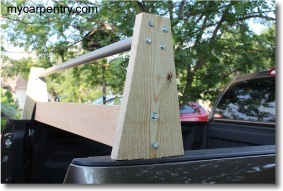
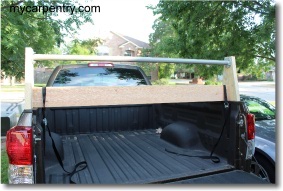
| Rear Truck Ladder Rack - installed and strapped in place | |
Special Notes:
* The total weight that these racks can carry has not been tested. I only tested them with the weight of my canoe (approximately 80 lbs.) on three separate successful trips.
* When strapping down my canoe, I strapped it to the tie down loops inside the bed, not the racks themselves. It is most likely okay to strap the canoe exclusively to the racks, but I felt that strapping it to the bed of the truck provided added security and peace of mind. I am still in the process of engineering the best tie down scenario.
* The material that you choose to use for the uprights is entirely up to you. I provided a couple of different options in this tutorial to show how either plywood or milled wood can be used.
What next?
Leave Truck Ladder Racks and visit our home page.


